The aim of this project is to develop my skills from studio practice A for example using different techniques in the metal workshop. Whilst also firstly learning to plan more prior to making my sculptures, by drawing and working out measurements before construction. I have based my artworks theme on architecture, one represents the old architectural ruins of pyramids, castles and cathedrals, and the second is very modern. I have shown the differences in the smallest details and different materials I have used, to emphasise the contrasts in both. The first sculpture represents old ruins and how time can negatively affect the state of the architecture. I chose materials that would be easy to shape which I then welded together. The work I have produced is based on a church spire and the light I have inserted within the sculpture throws shadows outside the structure that have a religious element with varying sized turrets that almost always are present on ancient castles. The tower is made from metal poles welded together in a pyramid shape with long sheets of metal welded and pressed onto the tower sides.
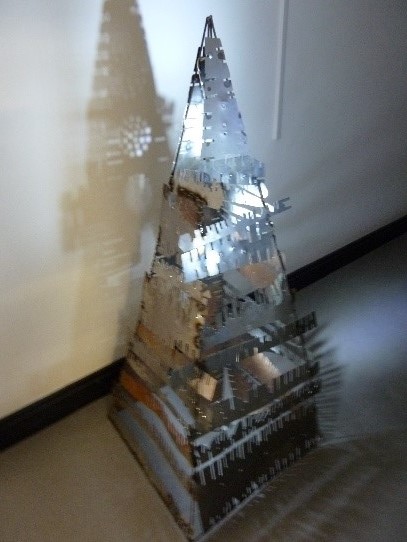
The metal sheets have then been cut with a knife press into different shapes to create shadows that will shine onto the gallery floor and walls.
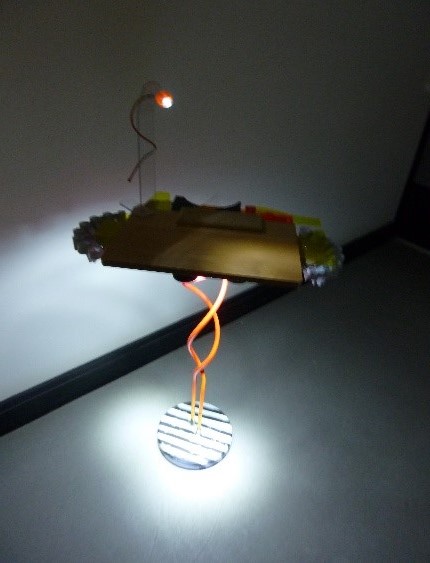
The second sculpture which uses more modern materials is in direct contrast to the first, which I have named my dream desk. It represents a modern architect’s desk made from materials that are available today and were not available hundreds of years ago.
Research:
Research for studio practice B has been a practical approach experimenting with different materials and methods, some have been successful and some haven’t worked as well. I have firstly tried working with wax to create a 3D tower however it didn’t work because it was too brittle therefore I decided not to carry on with this approach and stick to plastic, wood and metal, as they are more sturdy materials. Although this didn’t work out, it was a helpful learning curve for the future. Subsequently I have stuck with working with metal as this is my main interest and I wanted to develop my skills. I have worked closely with the metal technician Craig and my tutor Lewis to perfect old skills and learn new skills for example the laser cutter. Lewis also recommended me to try out woodwork which has worked very well as it has enhanced my project by bringing in a different material, and a sculpture quite different from the metal pyramid piece in both look and materials, but is still in keeping with my theme of architecture. Additionally I have also spent time working with third year fine art students to get advice and inspiration. I found this helpful as they gave me good suggestions on exhibiting my work, in order to make it more visually pleasing. They have also given me plenty of ideas for my project to grow and move forward.
Visual Research
For visual research, I took photos of new, brightly coloured buildings and old and new architecture that was pyramid shaped, as my artwork relates to both. These were taken in Middlesbrough, Darlington, Redcar, York and Newcastle
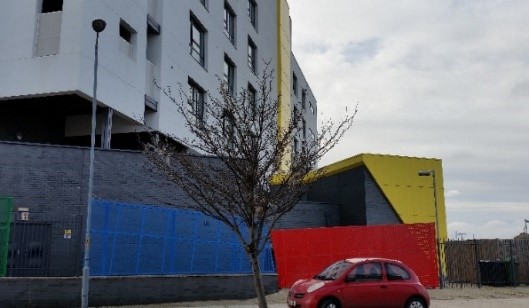
Photo of Middlesbrough college building, taken on 29/02/2016

Redcar Tower Clock, taken on 08/02/2016
Theoretical Research
I have also done more secondary research on new artists relating to my Studio Practice B works: Nancy Graves, David Umemoto and Oliver Kruze.
Nancy Graves was an American sculptor who lived from 1939 to 1995. She liked to use found materials and recycle them to make her sculptures, she cut them up changing them to make her brightly coloured sculptures, as I did for my dream desk. These sculptures are both made from steel and aluminium and painted with urethane paint.

‘Nike’, 1983, Nancy Graves
She had some idea to start with, based on plants but it still seems very random, akin to a controlled mess.

‘Trace’ 1981, Nancy Graves
Graves seemed like an independent woman who based her artwork on a lot of different things and didn’t want to stick to one theme such as feminism or any particular art theory.Graves has done a lot of metalwork sculptures which resemble bright and colourful plants from exotic countries. The strands of this artwork look like they are struggling to hold themselves up / hanging on a thread which are different from my artwork which is structurally sounder.
Both pieces could look top heavy and a mishmash of materials and colours, which could look unappealing as it is busy and confusing to the viewer but I think that makes them interesting as well.
David Umemoto is an architect and sculptor from Canada who works in brutalist concrete art. This style of ‘brutalism’ refers to architecture and buildings which many people don’t like, as it looks half-finished and doesn’t look too nice.
His work revolves around the idea of a universal set of rules and systems which everyone has to follow and ways they have to live their lives. He calls this a modular system.
His work is very intricate and confusing, e.g., stairs on a wall which lead nowhere and odd shapes. Like Graves’ work, it is a controlled, ‘strange’ mess. This relates to the complex shadows produced from my pyramid piece and the architectural themes of Umemoto, also relates continually through my 2nd year works. I like the way his small pieces lock together which could inspire my future work next year.

‘Interior I’, David Umemoto
Umemoto’s work is an organic process, a set-up which creates a building from cluttered pieces which still look half-done, especially with the edgy bumps around it. This would not work on a life-size building, but works aesthetically well with these pieces like building blocks for Lego.
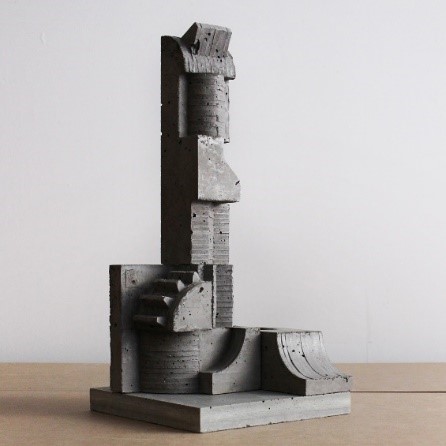
‘Friche I’, David Umemoto
I am inspired by how many different shapes he uses within an artwork, the finished pieces look as though a lot of thought has been put into them. These shapes remind me of buildings that I see every day, tower blocks from the brutalist art movement, but with a twist as the maze like structure’s and corridors go nowhere, shapes are added so well that ugly concrete structures are made beautiful. The ‘Friche I’ piece to the right looks like a clock tower or totem pole.
Oliver Kruse was born in Nuremburg in 1965 and has worked as a carpenter and artist in both Germany and Britain. Made out of wood, these pieces look like a wooden house where the pieces have been moulded into each other as if melting. This allows him to still use simple shapes but create a different design and a form of shelter like a bandstand.
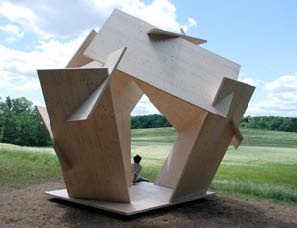
‘Interfere’ by Oliver Kruse and students & staff at Peter Behrens School of Architecture. On View: Spring 2011-Present
These pieces are more complicated than my work but are still interesting. Kruse by placing his sculptures outside rather than in a gallery, exposes viewers to the elements. You can also walk in and around the sculpture, with the artwork changing during different weather conditions, snow etc., and the landscape becomes part of the work – this changes how you feel about it.
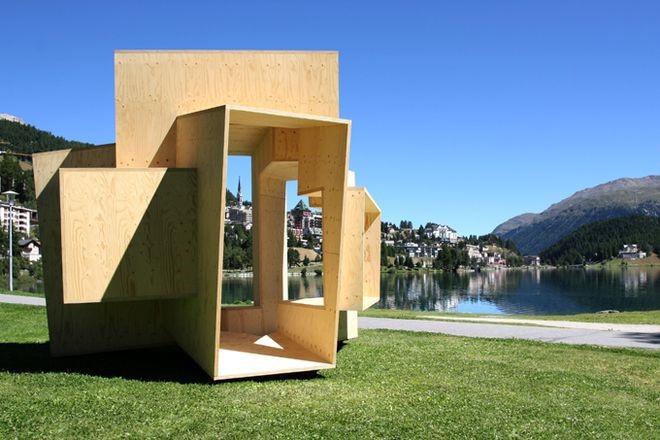
‘Interrelate’ by Oliver Kruse, St Moritz, 2015
Curatorial presentation:

The exhibition was held 16-18th March at the Arc in Stockton. The three pieces I exhibited were ‘Shadows of the Past’, ‘Future Enlightenment’ and ‘Demolition Crew’. The picture on the left shows me with ‘Shadows’ and ‘Future Enlightenment’ at the Arc. (Taken 16/03/2016)
I chose these three pieces because they all show the past and future themes of my work and my interest in architecture/buildings.
The first part of my work involved painting plinths white, of varied size that would bring each piece closer, to the eye level of the viewer, making it easier to get an idea of how my sculptures were made. The white plinths complemented the gallery walls, allowing my artwork with its darker colours to stand out more. This especially applies to my large metalwork piece,

‘Shadows of the Past’ 2016 (Steel rods and plates welded together)
To control the exhibition space, I blacked out the window with white presentation boards to try to darken the space. I also attached a ‘Please do not touch the artwork’ sign to the plinth as the metal sheeting had very sharp edges. Placing a square mirror the same size as the plinth in the base of ‘Shadows’, helped as I had designed this piece so to project light from within the pyramid, and throw shadows onto the two corner walls. Though the exhibition space was not ideal, as it was to light and there was only one place I could really display it, because the gallery had floor to ceiling windows, some shadows were still cast on the exhibition walls as intended.
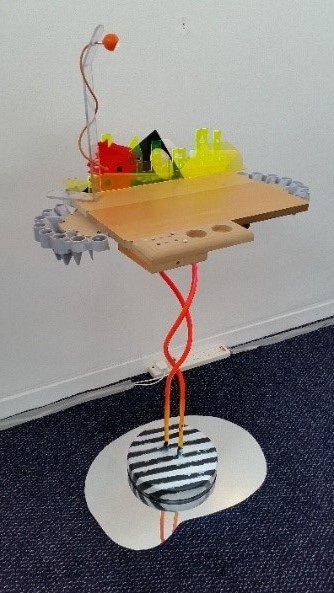
This piece was not placed on a plinth but on a mirror in the shape of a puddle. I did this to show the artwork from below and reflect the 6 on/off LEDs placed under the desk. Lighting beneath the desk also shone down onto the floor, creating more shadows and giving the piece a ‘spaceship feel’ / almost futuristic style.
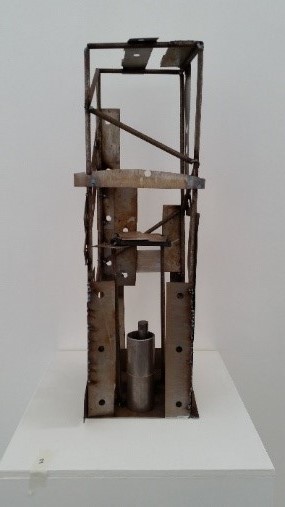
‘Demolition Crew’ 2015 (Welded metal tower)
I placed this piece close to the wall in order to replicate the positioning of my other sculptures, and a tall white plinth placed it at eye level. This also helped it throw shadows on the gallery walls, which was an unplanned bonus.
The positioning of my sculptures were all led by my largest the pyramid as this was to be my centre piece, and because this sculpture was to throw shadows on to the walls to add more depth to the piece, it had to be placed in close proximity to the wall. So my other works were also similarly positioned to complement each other, also the theatre door/fire exit and stairs could not be obstructed so this was also taken into consideration in positioning my three pieces.
Techniques & Methods of Working:
The aim of project B was to continue on using the skill set that I have developed and enhance this. I have mainly worked in the metal workshop and have used many different techniques, for example my welding skills have developed as this was my main technique to join pieces of metal together to create the 3D sculpture. However this term I have learnt to use different types of welders to create the best outcome, I have used both the MIG welder for larger pieces and also the spot welder for finer pieces, which I found challenging due to it needing to be neat. This term I have also learnt to cut and shape metal as this wasn’t a skill I acquired in project A. I have learnt how to use the cutting knife to cut strong pieces of metal into the shape I wanted. More challengingly I have learnt to use the laser cutter to cut precise shapes using a computer software to create patterns in plastic that represent cityscapes. These patterns were then added to the metal and wood sculpture, and using light sources shadows will be thrown down on the gallery floor. I have also used this machine to cut a hole in the plastic to fit a light source in neatly.
Another area I have developed is woodwork as this was recommended by Lewis to enhance my project. One machine I have learnt to use is the drill which puts holes in the wood so that screws can be placed in to join wood together. Additionally I have learnt to use sanders which I used to smooth the wood and also make it smaller if necessary. Smaller sanders have been used to make the drilled holes bigger to be able to fit wire and also lightbulbs through. I have also perfected my skills using the band saw to cut plastic and wood to the size I wanted.
Evaluation:
Work has been going well this semester, and I have become more comfortable with how much time I have to finish each piece. Experience of exhibiting has also been helpful and I am looking forward to coming back and doing more artwork next year. Written work is something I have struggled with, but discussing my artwork with lecturers and other students has helped me focus more on how I develop my artwork.
Working on the Arc exhibition in a group, however, was still challenging, as we disagreed over where to place our artwork.
Gaining new skills like metalwork has been very enjoyable, and working with more plastic and metal models is something I look forward to more next year. The workshop has given me some problems with my work – if there are problems with tools or machines, it can be difficult to be precise or check my work, meaning I end up rushing or making mistakes.
I have done more sculptures than painting this year. I became more interested in working with both hands and being more physical than painting. Working this way is also quicker for me than the drawing-like techniques of using one hand to paint. Visiting artist lectures have helped inspire me – though they are hard to relate to my work, their skills are valuable and I try to use these to develop my own style rather than simply copying their ideas.
Next year I would like to progress my shadow artworks and recycled rubbish theme further, building on from the works I have produced this year. Experimenting with more complex detailed shadows and sculptural works, hopefully so producing more in depth quality artworks, through attending workshops that will enhance my sculptural and practical workshop skills and also researching artists who work within a similar field and theme.
Bibliography:
Workshops
Wax workshops: Lewis Robinson.
Metal workshop: Lewis Robinson and Julian Wild.
Casting workshop/Rock modelling: Lewis Robinson.
Plastic workshop: Lewis Robinson.
Plaster workshop: Lewis Robinson.
Walking the streets workshop/Printing workshop: Alice Fox.
Aluminium casting workshop: Lewis Robinson.
Websites
Brutalism, Open University – http://www.open.edu/openlearn/history-the-arts/history/heritage/brutalism [Accessed 10/03/2016]
Nancy Graves, ‘Trace’, 1981 – http://www.invaluable.com/auction-lot/nancy-graves-1940-1995-110-c-v2ycfyumcn [Accessed 10/03/2016]
Nancy Graves, ‘Nike’, 1983 – http://collections.lacma.org/node/251582 [Accessed 10/03/2016]
David Umemoto, ‘Friche I’ – http://davidumemoto.com/friche-i [Accessed 10/03/2016]
David Umemoto, ‘interior I’ – http://davidumemoto.com/interior-i [Accessed 10/03/2016]
Oliver Kruse and students & staff at Peter Behrens School of Architecture, ‘Interfere’ – http://www.artomi.org/page.php?Interfere-by-Oliver-Kruse-24 [Accessed 10/03/2016]
Oliver Kruse, ‘Interrelate’ – http://www.stmoritzartmasters.com/walk-of-art/walk-of-art-365-days/st-moritz-oliver-kruse.html [Accessed 10/03/2016]
Books
Laura Oldfield Ford, Savage Messiah. London, Verso, 2011.
Brian Dillon, Ruin Lust. London, Tate Gallery Publishing, 2014.
Franzen, Brigette & Lager, Annette. Nancy Graves Project: & Special Guests. Publishd by HATJE CANTZ VERLAG GMBH & CO KG. 2013.
Nochlin, Linda. Lyon, Christopher & Hunter, Christina. Nancy Graves. Published by Mitchell-Innes & Nash. 2015
Visual Research/Exhibitions Visited
Working with third year students to gain advice and inspiration.
Mima Art Gallery.
Visit with Paul Merrick to Navigating North.
Python Galleries, Middlesbrough.
The House of Blah Blah, Middlesbrough.
Forbes Buildings, Middlesbrough.
The Hill Street Centre Gallery, Steve Irwin’s art plus 6 other artist, Exhibition: – Malfunctioning Authenticities.
The Arc Stockton. Exhibition:-The Illusion of Time, combining the work of 7 artist’s.
The Hill Street Centre, Unit 41. Exhibition:-Primer, Hosted by Zach Champion and 3 other artists.
York Art Gallery, York City, England. [Visited 21/3/16].
Baltic Centre for contemporary art, Newcastle, England. [Visited 25/3/16].
Laing Gallery, Newcastle, England. [Visited 25/3/16].
Visits to Redcar, Darlington and Middlesbrough College to photograph buildings new and old (2 photos used above).
Visits to old castles, Church’s/Abbey’s and ancient ruins in the North East of England to take photographs for research purposes.
Visiting Artists
Dryden Goodwin: landscape drawing.
Julian Wild: sculptural work.
Stephan Gill: photography work.
Alistair Hudson and Pavel Buchler: useful v useless art.
Assemble turner prize winners: architects.
Eleanor Wright’s: photography work.
